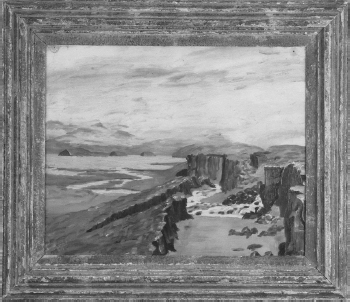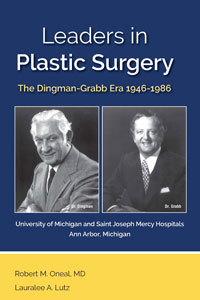
Leaders in Plastic Surgery
Skip other details (including permanent urls, DOI, citation information): This work is licensed under a Creative Commons Attribution-NonCommercial-NoDerivatives 3.0 License. Please contact [email protected] to use this work in a way not covered by the license.
For more information, read Michigan Publishing's access and usage policy.
Appendix
A-1. Visiting Plastic Surgery Professors during the Early Years of the University of Michigan Section of Plastic Surgery
1966–67: Mr. John Batstone, Oxford, England; Dr. Richard Stark, New York City; Dr. Ralph Millard, Miami; Dr. Ralph Blocksma, Grand Rapids; Drs. James Sullivan and George Baibak, Toledo; Dr. Richard Straith, Detroit; Dr. Robert Pool, Beaumont Hospital, Royal Oak, MI.
1967–68: Dr. Paul Pickering, San Diego; Dr. Ken Dorner, Kalamazoo; Dr. J. William Littler, New York City.
1968–69: Dr. Herbert Mehnert, Innsbruck, Austria; Dr. Hunter Fry, Melbourne, Australia; Dr. Herold Griffith, Northwestern University, Chicago; Dr. Tom Kendall, University of Kansas , Lawrence; Dr. C. G. Knowles, Lancaster, England.
1969–70: Mr. John Mustarde, Glasgow, Scotland. Famous oculoplastic surgeon and author of Plastic Surgery of the Orbital Region. He was visiting professor for three days, and he lectured, operated, and reviewed patients.
1970–71: Dr. M. Sasaki, Tokyo, Japan (drew the picture of L3); Dr. H. Schule, Stuttgart, Germany; Dr. Wolfgang Muhlbauer, Munich, Germany; Dr. Guellerma Raspall, Barcelona, Spain; Dr. Takehiko Ohura, Hokkaido, Japan
1971–72: These visitors were in addition to those participating in the faculty for Plastic Surgery in General Surgery Practice conference. Dr. Stuart Milton, Oxford, England; Dr. Bernard O’Brien, Melbourne, Australia; Dr. Ortiz Monasterio, Mexico City, Mexico.
1972–73: Dr. Guerro-Santos, Guadalajara, Mexico.
1973–74: The only visitors for that year were the faculty for the postgraduate course “Plastic Surgery in General Surgery Practice”: Dr. Paul Weeks, St. Louis; Dr. John Gaisford, Pittsburgh; Dr. Shattuck Hartwell, Cleveland; Dr. George Crickelair, New York City.
A-2. Plastic Surgery Residency Training in Ann Arbor/Saint Joseph Mercy Hospital (SJMH) and University of Michigan, 1958–86
Residents and Their Year of Graduation from the Program
| Natvig, Paul, MD | 1958 |
| Grabb, William, MD | 1961 |
| Bell, Gordon, MD | 1962 |
| Mauzy, Merritt, MD | 1962 |
| Stilwell, James, MD | 1962 |
| Alger, John, MD | 1963 |
| Au, Otto, MD | 1963 |
| Lucid, Morgan, MD | 1964 |
| Tipton, John, MD | 1965 |
| Davis, Don G., MD | 1966 |
| Oneal, Robert M., MD | 1966 |
| Knode, Robert, MD | 1967 |
| Russell, Jim, MD | 1967 |
| Chapple, John G., MD | 1968 |
| Constant, Errikos, MD | 1968 |
| Wilms, Fred, MD | 1968 |
| Borocz, Steve, MD | 1969 |
| Dodenhoff, Theodore, MD | 1969 |
| Ramos, Hernando, MD | 1969 |
| Seaton, Ralph, Jr., MD | 1969 |
| Glass, Leonard W., MD | 1970 |
| Hudak, Thomas, MD | 1970 |
| Kloster, Gilbert, MD | 1970 |
| Berner, Carl, MD | 1971 |
| Fairbanks, Grant, MD | 1971 |
| Geisterfer, Dirk, MD | 1972 |
| Greer, Donald, Jr., MD | 1972 |
| Wexler, Menachem, MD | 1972 |
| Cromwell, Terry A., MD | 1973 |
| Nobel, Gary, MD | 1973 |
| Thorvaldssen, Sigurdur, MD | 1973 |
| Norris, James, MD | 1974 |
| Novark, Bruce, MD, DDS | 1974 |
| O’Connor, John, MD, DDS | 1974 |
| Lawrence, Richard, MD | 1975 |
| MacCollum, Maxwell, MD | 1975 |
| Wilensky, Robert J., MD, PhD | 1975 |
| Agris, Joseph, MD, DDS | 1976 |
| Blackburn, Bill, MD | 1976 |
| Bucko, Dennis, MD | 1976 |
| Mes, Louis G. B., MD | 1977 |
| Newman, M. Haskell, MD | 1977 |
| Olesen, R. Merrel, MD | 1977 |
| Austad, Eric, MD | 1978 |
| Dempsey, Paul, MD | 1978 |
| Izenberg, Paul, MD | 1978 |
| Argenta, Lou, MD | 1979 |
| Berkowitz, R. Laurence, MD | 1979 |
| Zelnik, Jonathan, MD | 1979 |
| Chapin, Donald, MD | 1980 |
| Gunter, Jack P., MD | 1980 |
| Jones, Neil F., MD | 1981 |
| Manders, Ernest, MD | 1981 |
| Watanabe, Michael, MD | 1981 |
| Gilman, Robert H., MD, DMD | 1982 |
| Fairbanks, Grant, MD | 1982 |
| Harder, Glenn, MD | 1982 |
| Marks, Malcolm, MD | 1982 |
| Derman, Gordon, MD | 1983 |
| Duus, Erlan, MD | 1983 |
| Friedman, Roger, MD | 1984 |
| Pollock, Richard, MD | 1984 |
| Zucker, Stephen, MD | 1984 |
| Anderson, Richard, MD | 1985 |
| Hamm, Jeffrey, MD | 1985 |
| Rohrich, Rodney J., MD | 1985 |
| Adson, Martin, MD | 1986 |
| Thornton, James, MD | 1986 |
| VanderKolk, Craig A., MD | 1986 |
| Fang, Kim, MD, DDS | 1987 |
| Iacobucci, John, MD | 1987 |
| Nguyen, Abram, MD | 1987 |
A-3. Henry Ford Hospital (HFH) and Rotations of Its Residents in Ann Arbor
Drs. Robert Clifford and Alexander Kelly started practice at HFH in Detroit, Michigan, in 1952 and began the residency program there in 1958. Dr. Clifford was the initial chief but died soon thereafter, and Dr. Kelly became chief. Dr. Kelly remained in this position until 1981, when Dr. Don Ditmars, who had rotated in the plastic surgery program in Ann Arbor during his residency at Ford Hospital, became program director. Dr. Robert Pool, one of the early resident trainees at Ford, later started the plastic surgery residency program at William Beaumont Hospital, Royal Oak, Michigan. He innovated an important modification of the Millard unilateral cleft lip repair (previously discussed). As mentioned, he also graciously participated in the teaching program at the University of Michigan over a number of years. According to Dr. John Markley, his father, also a surgeon, knew Dr. Pool at Beaumont and told John that Dr. Pool was also a very proficient hand surgeon. He once presented John with a collection of slides of a very nicely documented series of hand dissections.
List of HFH Resident Rotators
- 1962: Cesar Olivas Lozoya, MD
- 1965: Joe Fox, MD
- 1966: Earl Norling, MD; Alfred Speirs, MD; and Harvey Weiss, MD
- 1967: Bob Woodall, MD, and Chosen Lau, MD
- 1969: Reza Karimipour, MD
- 1970: Don Ditmars, MD and John Elmquist, MD
- 1971: John Balfour, MD
- 1972: W. Peter McCabe, MD
- 1973: V. Sathyvy, MD
- 1974: Saleem Malik, MD
- 1975: Tom Shinabeck, MD
- 1976: Jorge Gomez, MD
- 1977: Andrew Abrams, MD
A-4. Visiting Fellows in the Plastic Surgery Program
- 1963: G. W. Naraywa SJMH Fellowship
- 1971: David Chiu-Hwa Lin from Taiwan
- 1973: Warwick Molteno Montague Morris from South Africa
- 1973: Samuel Valia
- 1974: Alphonse Roy from Montreal
- 1977: Issac Peled from Israel
- 1978: Khalil Abu-Dalu from Israel
- 1979: Hassan Badran from Egypt
- 1981: Paul Tomljanovich from New York City
- 1982: Georgio Zadini from Italy (stayed only three to four months)
A-5. Drs. Dingman (ROD), Grabb (WCG), and Oneal’s (RMO) Travel Club Members
Dr. Dingman: Drs. Joseph Murray, Peter Randall, John M. Converse, Herb Conway, “Willy White,” Ralph Millard, Frank Ashley, Paul “Pick” Pickering—met at national meetings and at other times and locations but records not obtainable.
Dr. Grabb: Drs. Jerry Bains, Jack Hoopes, Ian Jackson, Josh Jurkiewicz, J. B. Lynch (deceased), Gene Sherlock, John Simons, Jim Smith (deceased), Mel Spira, Hugh Thompson (deceased), Paul Weeks—some of the most prominent men in the field. The meetings always included wives and were held in the host’s city and were primarily scientific in content.
Dr. Oneal: Drs. Bob Knode, Lenny Glass, Carl Berner, Dave Dingman,Ted Dodenhoff—members were all, except Dave Dingman (who trained with Dr. Ray Broadbent at University of Utah), residents who trained at Michigan in my early years as assistant professor. So we were all close to the same age. All of us had successful private practices in the West and Midwest of the country. All the meetings we had were stag except for one. We always went to some interesting and exciting locale, for skiing, golf, boating, or fishing. About half the time away was spent in formal scientific meetings or informal discussions about techniques, experiences in practice, and unsolved clinical problems.
As different as the groups were, the results were similar in that there was a great deal of interesting, important, and innovative information exchanged, providing a quality of knowledge that is priceless.
A-6. Sasaki’s Drawing of Lauralee Lutz

A-8. Dr. Grabb’s “Ten Most Wanted” Lists
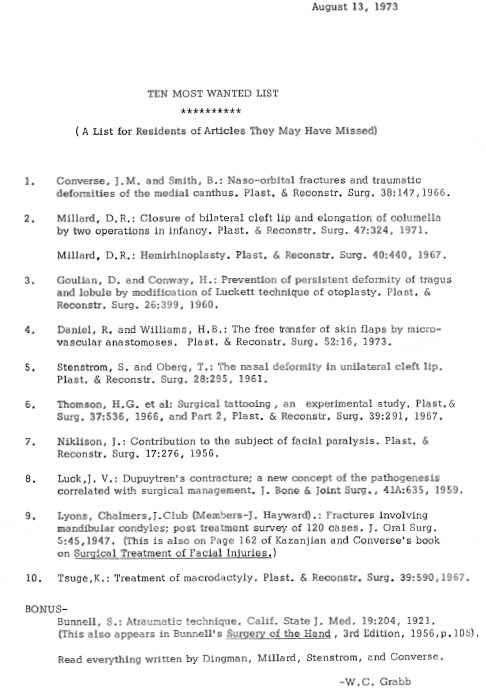
A-9. Two Letters Regarding Changes in ROD Society
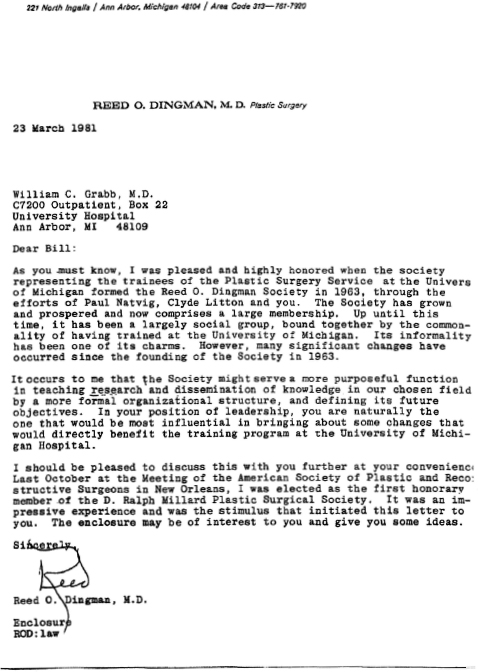
A-12. The Cover of the Book A Message to Garcia

A-14. Quotes from William Osler

A-15. A Copy of Dr. Dingman’s Motto, Quotations, and Advice to Residents
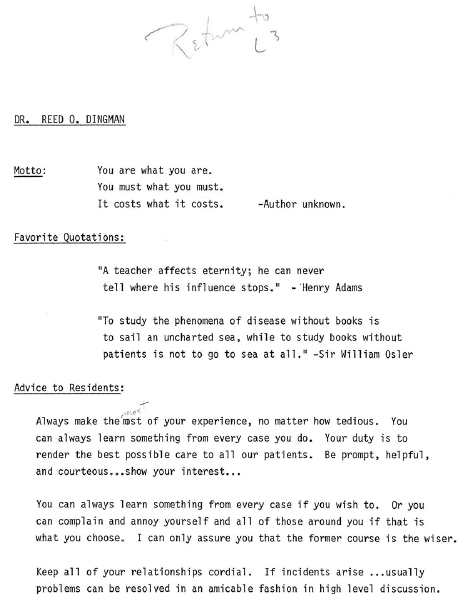
A-16. Gillies’s Painting
